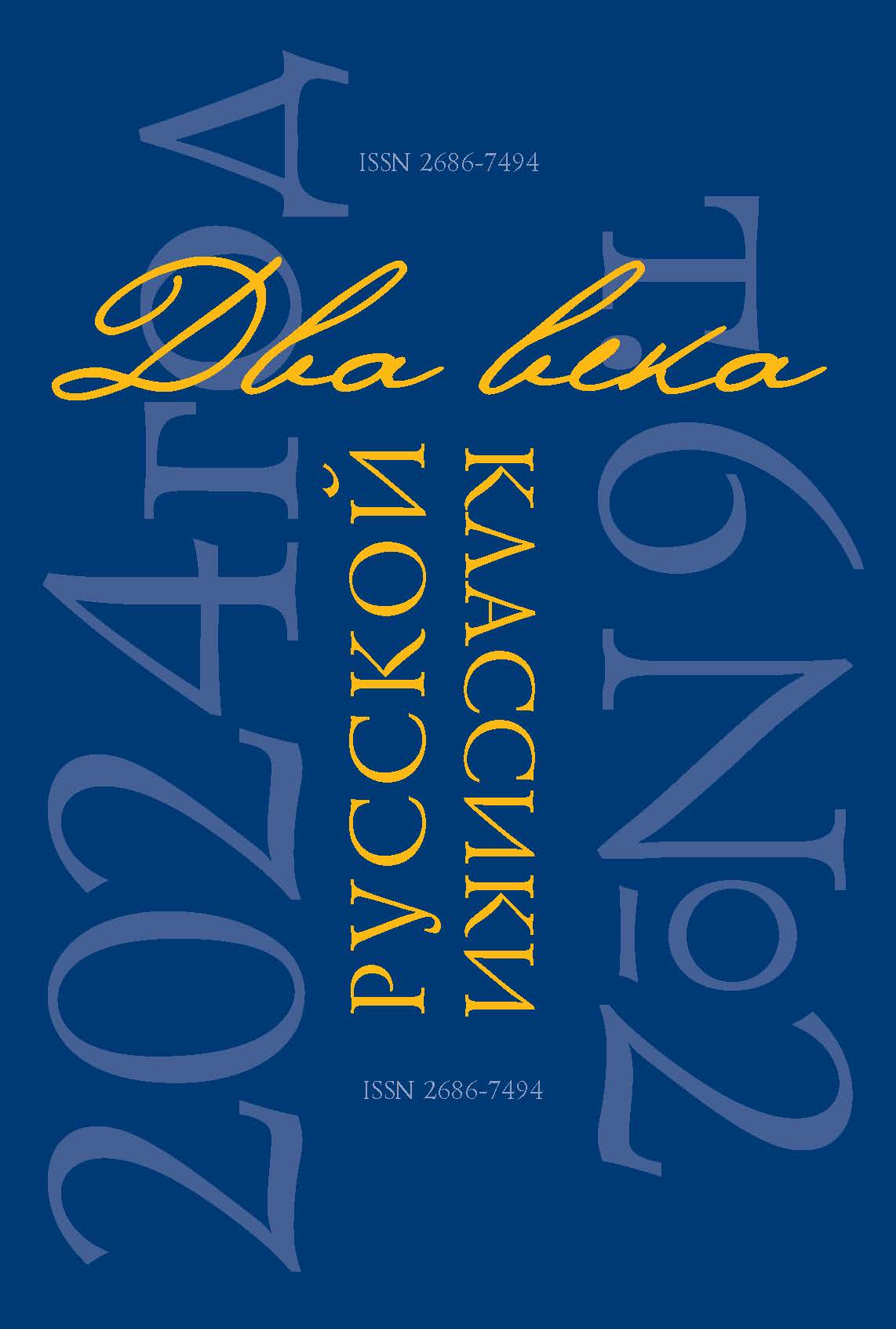Acknowledgments: This work was carried out with financial support from the Russian Science Foundation, project no. 23-28-01302, https://rscf.ru/ project/23-28-01302/
Abstract: The article provides a historiography of the coverage of the theme of adolescence in the works of L. N. Tolstoy and F. M. Dostoevsky. An axiological approach to the works of both writers by the famous scientist and thinker A. A. Ukhtomsky allows us to explore the spiritual and moral issues of the works. The story “Childhood” and the novel “The Brothers Karamazov” show the types of proud characters — this is Tolstoy’s Nikolenka and Dostoevsky’s Ilyusha Snegirev. Due to their pride and the desire to please others, both characters experience a similar state of “eclipse,” when carnal feelings drown out the “natural” law. Kolya Krasotkin, like Nikolenka, is carried away by rationalism, which leads both characters to a spiritual crisis.
References
Babuk, A. V. Khudozhestvennaia antropologiia detstva v literature XIX v. [Artistic Anthropology of Childhood in the Literature of the 19th Century]. Minsk, Belarusian State University Publ., 2018. 144 p. (In Russ.)
Bilinkis, Ia. S. Novatorstvo L. N. Tolstogo v trilogii “Detstvo”, “Otrochestvo”, “Iunost’” [Innovation of L. N. Tolstoy in the Trilogy “Childhood,” “Adolescence,” “Youth”]. Leningrad, Herzen Russian State Pedagogical University Publ., 1973. 40 p. (In Russ.)
Gorodilova, N. I. “Epicheskaia kartina mira v trilogii L. N. Tolstogo ʽDetstvo’, ʽOtrochestvo’, ʽIunost”.” [“The Epic Picture of the World in L. N. Tolstoy’s Trilogy ʽChildhood,’ ʽAdolescence,’ ʽYouth’.”] Filologicheskie nauki. Voprosy teorii i praktiki, no. 9, 2020, pp. 5–12. http://doi.org/10.30853/filnauki.20209.1 (In Russ.)
Kazakov, A. A. “Tsennostnaia arkhitektonika proizvedenii L. N. Tolstogo: k problem ʽantidialogicheskoi’ fenomenologii esteticheskogo sobytiia” [“Value Architectonics of L. N. Tolstoy’s Works: To the Problem of ʽAnti-Dialogue’ Phenomenology of an Aesthetic Event”]. Sibirskii filologicheskii zhurnal, no. 4, 2014, pp. 134–143. (In Russ.)
Kruglik, L. Ia. Realizm trilogii L. N. Tolstogo “Detstvo”, “Otrochestvo”, “Iunost’” [Realism of L. N. Tolstoy’s Trilogy “Childhood,” “Adolescence,” “Youth”: PhD Thesis, Summary]. Moscow, 1961. 19 p. (In Russ.)
Loshchinin, N. P. “Detstvo”, “Otrochestvo”, “Iunost’” L. N. Tolstogo. Problematika i khudozhestvennye osobennosti [“Childhood,” “Adolescence,” “Youth” by L. N. Tolstoy. Problems and Artistic Features]. Tula, Tul’skoe knizhnoe izdatel’stvo Publ., 1955. 48 p. (In Russ.)
Mikhniukevich, V. L. “Poetika detskikh obrazov F. M. Dostoevskogo v kontekste ʽnarodnogo khristianstva’.” [“Poetics of Children’s Images of F. M. Dostoevsky in the Context of ʽFolk Christianity’.”] Vestnik Cheliabinskogo gosudarstvennogo universiteta. Seriia 2. Filologiia, vol. 2, no, 1, 1994, pp. 21–28. (In Russ.)
Odinokov, V. G. Trilogiia L. N. Tolstogo “Detstvo”, “Otrochestvo”, “Iunost’” [Trilogy of L. N. Tolstoy “Childhood,” “Adolescence,” “Youth”: PhD Thesis, Summary]. Moscow, 1953. 15 p. (In Russ.)
Skaftymov, A. P. Poetika khudozhestvennogo proizvedeniia [Poetics of a Work of Art]. Moscow, Vysshaia shkola Publ., 2007. 535 p. (In Russ.)
Skiperskikh, A. V. “Mezhdu Gospodom i gospodinom: diskurs boli v tekstakh F. M. Dostoevskogo: politiko-kul’turnoe izmerenie” [“Between God and Master: The Discourse of Pain in the Texts of F. M. Dostoevsky: Political and Cultural Dimension”]. PolitBook, no. 4, 2015, pp. 166–170. (In Russ.)
Sozina, T. N. “ʽTrogatel’noe’ kak sposob proiavleniia avtorskogo golosa v romane ʽBrat’ia Karamazovy’ F. M. Dostoevskogo” [“ʽTouching’ as a Way of Manifesting the Author’s Voice in the Novel ʽThe Brothers Karamazov’ by F. M. Dostoevsky”]. Vestnik Cheliabinskogo gosudarstvennogo universiteta, no. 9, 2008, pp. 134–138. (In Russ.)
Tsirulev, A. F. “ʽPoeticheskaia ideia’ v trilogii L. N. Tolstogo ʽDetstvo’, ʽOtrochestvo’, ʽIunost’’.” [“ʽPoetic Idea’ in L. N. Tolstoy’s Trilogy ʽChildhood,’ ʽAdolescence,’ ʽYouth’]. Vestnik Leningradskogo gosudarstvennogo universiteta im. A. S. Pushkina, no. 3, 2011, pp. 27–32. (In Russ.)
Chuprina, I. V. Trilogiia L. N. Tolstogo “Detstvo”, “Otrochestvo”, “Iunost’” v svete ideinoi i literaturnoi zhizni 40–50 godov [Trilogy of L. N. Tolstoy “Childhood,” “Adolescence,” “Youth” in the Light of the Ideological and Literary Life of the 40–50s: PhD Thesis, Summary]. Saratov, 1952. 27 p. (In Russ.)
Fedorova, E. A. “Teleologicheskii siuzhet v romanakh ʽKapitanskaia dochka’ i ʽVoi- na i mir’.” [“Teleological Plot in the Novels ʽThe Captain’s Daughter’ and ʽWar and Peace’.”] Problemy istoricheskoi poetiki, no. 4, 2023, pp. 102–129. https://doi.org/10.15393/ j9.art.2023.13123 (In Russ.)









